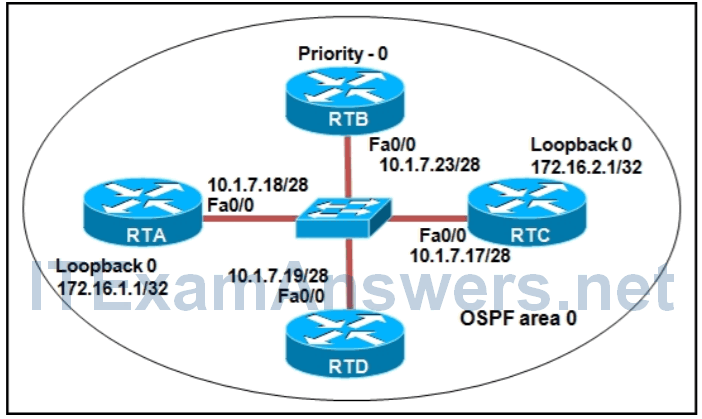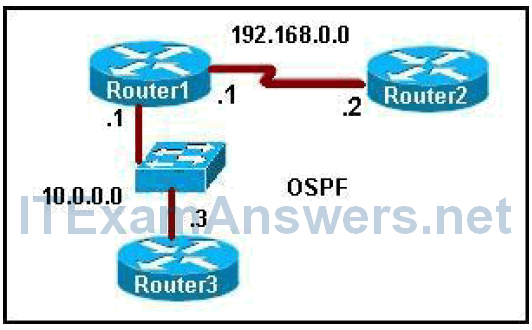1. Refer to the exhibit. What destination address will RTB use to advertise LSAs?
- 172.16.1.1
- 255.255.255.255
- 224.0.0.5
- 172.16.2.1
- 224.0.0.6*
- 10.1.7.17
2. What does the Cisco IOS use to calculate the OSPF cost to a destination network?
- bandwidth and reliability
- bandwidth and hop count
- bandwidth, load, and reliability
- bandwidth*
3. Which two statements are true about multiarea OSPF? (Choose two.)
- Internal routers maintain a separate linkstate database for each area to which they are attached.
- A stub area does not accept information from other OSPF areas.
- ABRs maintain a separate linkstate database for each area to which they are attached.*
- A stub area does not accept information from outside the OSPF autonomous system.*
4. What are two reasons for creating an OSPF network with multiple areas? (Choose two.)
- to reduce use of memory and processor resources*
- to simplify configuration
- to ensure that an area is used to connect the network to the Internet
- to provide areas in the network for routers that are not running OSPF
- to reduce SPF calculations*
5. For OSPF, which three options must be the same within the hello packet that is exchanged between two adjacent routers? (Choose three.)
- DR/BDR assignments
- hello/dead intervals*
- router priority
- stub flag*
- area ID*
6. Refer to the diagram. Which state is RTB in if it sees itself in the RTA hello but no routing information has been exchanged?
- down state
- init state
- twoway state*
- loading state
- attempt state
7. Refer to the exhibit. When OSPF is operational and converged, what neighbor relationship is developed between Router1 and Router2?
- A 2WAY adjacency is formed.
- Both routers will become DROTHERS.
- Router2 will become the DR and Router1 will become the BDR.
- A FULL adjacency is formed.*
8. Refer to the exhibit. What does the state “FULL/ ” indicate?
- The DR/BDR election is currently taking place.
- RouterA could not form a neighbor relationship with the router with router ID 10.112.0.34.
- The router with router ID 10.112.0.34 and RouterA are on a point-to-point network.*
- OSPF hello and dead timers between RouterA and the router with router ID 10.112.0.34 do not match.
9. A network administrator is implementing OSPF in a portion of the network and must ensure that only specific routes are advertised via OSPF. Which network statement would configure the OSPF process for networks 192.168.4.0, 192.168.5.0, 192.168.6.0, and 192.168.7.0, now located in the backbone area, and inject them into the OSPF domain?
- r1(config-router)# network 192.168.4.0 0.0.3.255 area 1
- r1(config-router)# network 192.168.4.0 0.0.15.255 area 1
- r1(config-router)# network 192.168.0.0 0.0.3.255 area 0
- r1(config-router)# network 192.168.4.0 0.0.255.255 area 0
- r1(config-router)# network 192.168.0.0 0.0.0.255 area 1
- r1(config-router)# network 192.168.4.0 0.0.3.255 area 0*
10. A network administrator is planning an OSPF implementation and must ensure proper router DR/BDR assignments. What is the default interface priority value for OSPF routers?
- 100
- 1*
- 0
- 255
11. What does OSPF use to reduce the number of exchanges of routing information in networks where large numbers of neighbors are present? (Choose two.)
- designated router*
- backup root router
- backup domain router
- domain router
- root router
- backup designated router*
12. In an OSPF hub-and-spoke topology, what needs to be done to ensure that the spoke routers would never be selected as DR and BDR?
- All spoke routers need to be configured with an OSPF interface priority of 0 (ip ospf priority) so that they will not become the DR/BDR.*
- All routers must be configured with an OSPF interface priority of 0 (ip ospf priority) to disable the DR/BDR election process.
- Because nonbroadcast networks do not elect a DR/BDR, nothing needs to be done.
- One of the spoke routers will need to be configured as the DR by setting the OSPF interface priority higher than 1 (ip ospf priority).
13. Which two statements are correct about OSPF route summarization? (Choose two.)
- OSPF can perform automatic summarization on major classful network boundaries even if no summarization commands are entered from the CLI.
- Once OSPF route summarization is configured, the summary route will be advertised even if none of the networks in the address range are in the routing table.
- Automatic OSPF route summarization is performed by the ABR.
- The metric of the summary route is equal to the lowest cost network within the summary Correct! address range.*
- The area 51 range 172.0.0.0 255.0.0.0 command identifies area 51 as the area that contains the range of networks to be summarized.*
14. Which two statements are true abut interarea and intraarea routes in multiarea OSPF? (Choose two.)
- An internal router will add the cost to reach a specific ABR to the cost announced in a type 3 LSA*
- Inter-area route is always preferred over an intra-area route
- Intra-area route is always preferred over an inter-area route*
- For an intra-area route, an internal router will only consider the cost to reach a specific ABR
15. In which two types of areas will the ABR forward LSA 3s into an area? (Choose two.)
- Normal area*
- You Answered Totally stubby area
- Stub area*
- Totally stubby NSSA area
16. Which of the following statements are true regarding OSPFv3? (Choose two.)
- Uses IPv4 to transport OSPFv3 messages for IPv4 and IPv6 to transport OSPFv3 messages for IPv6
- Uses IPv6 to transport OSPFv3 messages for IPv4 and OSPFv3 Correct! messages for IPv6*
- Uses a 32bit router ID for configuring OSPFv3 for IPv4 and IPv6*
- Uses a 32bit router ID for configuring OSPFv3 for IPv4 and a 128bit router ID for OSPFv3 for IPv6
17. Which global configuration command is used to enter OSPFv3 using address families?
- Router(config)# ipv6 router ospf 1
- Router(config)# ipv6 router ospfv3 1
- Router(config)# router ospfv3 1 *
- Router(config)# ospfv3 1
18. Which two statements are true when using OSPFv3 to connect to a router that is only advertising OSPFv3 routes for IPv4 networks?
- IPv4 is used as the protocol to carry the OSPFv3 messages.
- Both routers need to have an IPv6 address on their adjacent interfaces.*
- IPv6 addressing is not required on the router that is only advertising OSPFv3 routes for IPv4 networks
- IPv6 is used as the protocol to carry the OSPFv3 messages.*
19. Which type of LSA is generated by the ABR to identify and provide a route to the ASBR?
- Type 2 LSA
- Type 3 LSA
- Type 5 LSA
- Type 4 LSA*
- Type 1 LSA
20. Which type of LSA is generated by the ASBR when configured with a default static route and the OSPF defaultinformation originate command?
- Type 2 LSA
- Type 1 LSA
- Type 5 LSA*
- Type 4 LSA
- Type 3 LSA
Download PDF File below:

Hi where could I found ccnp enterprise quastion?